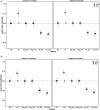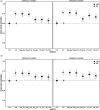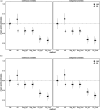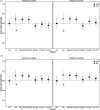Handling of outcome missing data dependent on measured or unmeasured background factors in micro-randomized trial: Simulation and application study
- PMID: 38698826
- PMCID: PMC11064756
- DOI: 10.1177/20552076241249631
Handling of outcome missing data dependent on measured or unmeasured background factors in micro-randomized trial: Simulation and application study
Abstract
Background: Micro-randomized trials (MRTs) enhance the effects of mHealth by determining the optimal components, timings, and frequency of interventions. Appropriate handling of missing values is crucial in clinical research; however, it remains insufficiently explored in the context of MRTs. Our study aimed to investigate appropriate methods for missing data in simple MRTs with uniform intervention randomization and no time-dependent covariates. We focused on outcome missing data depending on the participants' background factors.
Methods: We evaluated the performance of the available data analysis (AD) and the multiple imputation in generalized estimating equations (GEE) and random effects model (RE) through simulations. The scenarios were examined based on the presence of unmeasured background factors and the presence of interaction effects. We conducted the regression and propensity score methods as multiple imputation. These missing data handling methods were also applied to actual MRT data.
Results: Without the interaction effect, AD was biased for GEE, but there was almost no bias for RE. With the interaction effect, estimates were biased for both. For multiple imputation, regression methods estimated without bias when the imputation models were correct, but bias occurred when the models were incorrect. However, this bias was reduced by including the random effects in the imputation model. In the propensity score method, bias occurred even when the missing probability model was correct.
Conclusions: Without the interaction effect, AD of RE was preferable. When employing GEE or anticipating interactions, we recommend the multiple imputation, especially with regression methods, including individual-level random effects.
Keywords: Micro-randomized trial; missing data; mobile app; mobile health; multiple imputation.
© The Author(s) 2024.
Conflict of interest statement
The authors declared no potential conflicts of interest with respect to the research, authorship, and/or publication of this article.
Figures





Similar articles
-
A comparison of different methods to handle missing data in the context of propensity score analysis.Eur J Epidemiol. 2019 Jan;34(1):23-36. doi: 10.1007/s10654-018-0447-z. Epub 2018 Oct 19. Eur J Epidemiol. 2019. PMID: 30341708 Free PMC article.
-
Imputation strategies for missing binary outcomes in cluster randomized trials.BMC Med Res Methodol. 2011 Feb 16;11:18. doi: 10.1186/1471-2288-11-18. BMC Med Res Methodol. 2011. PMID: 21324148 Free PMC article.
-
Properties and pitfalls of weighting as an alternative to multilevel multiple imputation in cluster randomized trials with missing binary outcomes under covariate-dependent missingness.Stat Methods Med Res. 2020 May;29(5):1338-1353. doi: 10.1177/0962280219859915. Epub 2019 Jul 11. Stat Methods Med Res. 2020. PMID: 31293199
-
Data Missing Not at Random in Mobile Health Research: Assessment of the Problem and a Case for Sensitivity Analyses.J Med Internet Res. 2021 Jun 15;23(6):e26749. doi: 10.2196/26749. J Med Internet Res. 2021. PMID: 34128810 Free PMC article.
-
Review: a gentle introduction to imputation of missing values.J Clin Epidemiol. 2006 Oct;59(10):1087-91. doi: 10.1016/j.jclinepi.2006.01.014. Epub 2006 Jul 11. J Clin Epidemiol. 2006. PMID: 16980149 Review.
References
-
- Bates DW, Landman A, Levine DM. Health apps and health policy: what is needed? JAMA 2018; 320: 1975–1976. - PubMed
LinkOut - more resources
Full Text Sources

